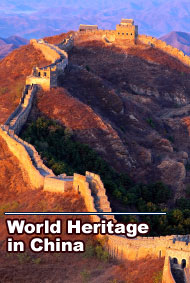
|
|
|
Mt. Huangshan (Huangshan City, Anhui Province)
Brief Introduction Located in the south of Anhui Province, straddling Shexian, Yixian, Taiping and Xiuning counties. It was called Mt. Yishan in the Qin Dynasty, and got its current name in 747 during the Tang Dynasty. The scenic area covers 154 sq. km, and is celebrated for its peaks, rocks, pines, clouds and springs. The renowned Four Wonders of Mt. Huangshan are the spectacular rocks, odd-shaped pines, hot springs and sea of clouds. Other attractions are lakes, waterfalls, streams, rare flowers and animals. Forests cover 83.4% of the area, with some 1,452 species of native plant which fall into 203 families. Mt Huangshan also has a rich cultural heritage. Xu Xiake, a famous traveler of the Ming Dynasty visited Huangshan twice, and described it in a poem, calling it best of all mountains in China. Cultural Heritage Mt. Huangshan has long been closely connected with religion. As early as in the Tang Dynasty, stories about Huangdi (the Yellow Emperor), and the alchemists Rongchengzi and Fuqiugong making pills of immortality on Mt. Huangshan were recorded. Many peaks are named after them, such as Xanyuan Peak, Fuqiu Peak and Pill-making Peak. Even the name Huangshan is related to the story of the Yellow Emperor's making of pills of immortality. Taoist temples built on Huangshan in the early days are Fuqiu Temple, Nine-Dragon Temple and so on. Since the end of the Ming Dynasty Buddhism has taken the place of Taoism in Huangshan culture. Buddhist monasteries have been built in large numbers, among which, Xiangfu, Ciguang, Cuiwei and Zhibo are called the Four Big Monasteries of Huangshan. Generation after generation, people have come to eulogize Mt. Huangshan, resulting in a rich legacy of art and literature. Some artists have even formed the Huangshan school. Besides, there are numerous and widespread fairy tales and legends about the Mountain. Natural Heritage Mt. Huangshan has a complex geological history. The formation of the peaks dates back to the Jurassic Period of the Mesozoic Era as a result of crustal movements and subsequent uplift. During the late Mesozoic Era and the early Cenozoic Era, a large amount of granite magma erupted through fissures due to further crustal movements, which became the main body of the Mountain after cooling down. Geologically, Huangshan is located in the transitional area between two structures. Granite formation is characterized by faults and joints. The major faults include the Huangshan fault (or Xiaoyaoxi fault), Lotus Peak fault, the fault at the back of the Mountain and the fault along the way from Paiyun Pavilion to Xihaigou. These joints are well advanced into four major groups. They are cubical, vertical, longitudinal, latitudinal, X-shaped or irregular in terms of shape. Huangshan also shows evidence of later glaciation during the Quaternary Period, as pointed out in 1936 by Li Siguang, a renowned Chinese geologist. Thanks to the complicated natural environment, Huangshan has a well-preserved ecosystem. Vegetation covers 82.6% and forest, 56% of the total land area. Some 1,450 plant species are native to the area, of which one is under first grade protection; four are under second grade, and eight under third grade. There are ten species on the verge of extinction, with six endemic to China and two to Huangshan. Legends and Stories The wonderful scenery of Mt. Huangshan has attracted many visitors. Among them were said to be immortals, like the Yellow Emperor, the Dragon King and even the Eight Immortals. The story goes that once on the day of the annual gathering of the Eight Immortals, seven of them arrived on time, while Han Xiangzi was late. Zhang Guolao guessed that Han must have been fascinated by the scenery of Mt. Huangshan on his way. Then Zhang Guolao flew into the sky to look for Han Xiangzi. Just as Zhang expected, Han was sightseeing on Mt. Huangshan. He was enjoying himself so much that he forgot the gathering. Zhang tried every possible way to persuade Han to leave. Han, however, was reluctant to go, and turned a stone into a replica of himself, in case he forgot the way to Huangshan the next time. The stone therefore was named Immortal Showing the Way. Zhang, for fear that Han would slip away again, rode backwards on his donkey to keep Han in sight and also to keep seeing the Mountain. |